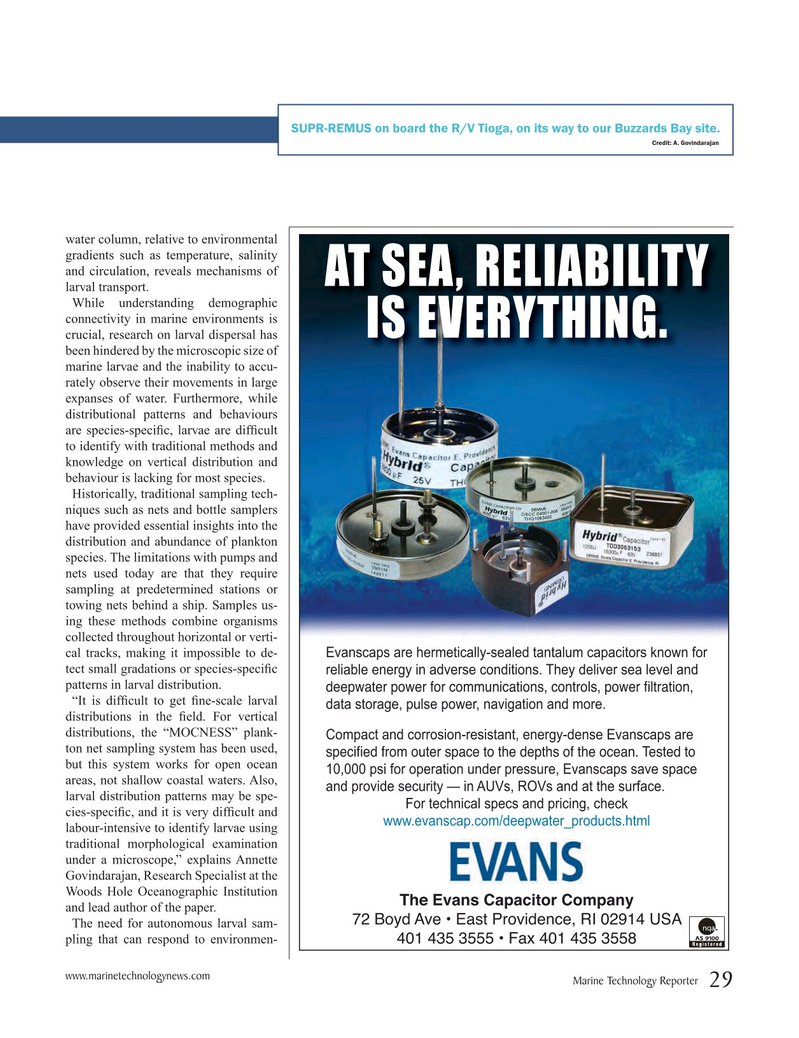
Page 29: of Marine Technology Magazine (October 2015)
AUV Operations
Read this page in Pdf, Flash or Html5 edition of October 2015 Marine Technology Magazine
SUPR-REMUS on board the R/V Tioga, on its way to our Buzzards Bay site.
Credit: A. Govindarajan water column, relative to environmental gradients such as temperature, salinity and circulation, reveals mechanisms of
AT SEA, RELIABILITY larval transport.
While understanding demographic connectivity in marine environments is
IS EVERYTHING.
crucial, research on larval dispersal has been hindered by the microscopic size of marine larvae and the inability to accu- rately observe their movements in large expanses of water. Furthermore, while distributional patterns and behaviours are species-speci? c, larvae are dif? cult to identify with traditional methods and knowledge on vertical distribution and behaviour is lacking for most species.
Historically, traditional sampling tech- niques such as nets and bottle samplers have provided essential insights into the distribution and abundance of plankton species. The limitations with pumps and nets used today are that they require sampling at predetermined stations or towing nets behind a ship. Samples us- ing these methods combine organisms collected throughout horizontal or verti- cal tracks, making it impossible to de-
Evanscaps are hermetically-sealed tantalum capacitors known for tect small gradations or species-speci? c reliable energy in adverse conditions. They deliver sea level and patterns in larval distribution.
GHHSZDWHUSRZHUIRUFRPPXQLFDWLRQVFRQWUROVSRZHUÀOWUDWLRQ “It is dif? cult to get ? ne-scale larval data storage, pulse power, navigation and more.
distributions in the ? eld. For vertical distributions, the “MOCNESS” plank-
Compact and corrosion-resistant, energy-dense Evanscaps are ton net sampling system has been used,
VSHFLÀHGIURPRXWHUVSDFHWRWKHGHSWKVRIWKHRFHDQ7HVWHGWR but this system works for open ocean 10,000 psi for operation under pressure, Evanscaps save space areas, not shallow coastal waters. Also, and provide security — in AUVs, ROVs and at the surface. larval distribution patterns may be spe-
For technical specs and pricing, check cies-speci? c, and it is very dif? cult and www.evanscap.com/deepwater_products.html labour-intensive to identify larvae using traditional morphological examination under a microscope,” explains Annette
Govindarajan, Research Specialist at the
Woods Hole Oceanographic Institution
The Evans Capacitor Company and lead author of the paper.
%R\G$YH?(DVW3URYLGHQFH5,86$
The need for autonomous larval sam- pling that can respond to environmen- ?)D[ www.marinetechnologynews.com
Marine Technology Reporter 29

 28
28

 30
30
